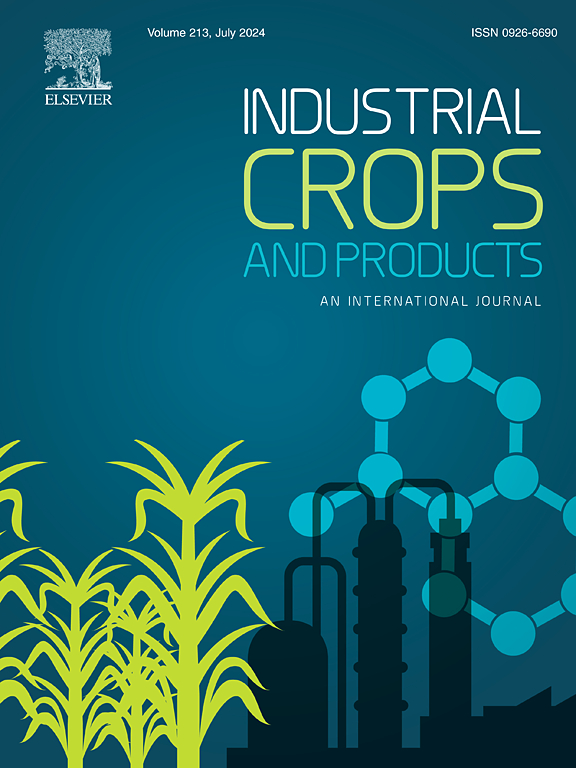pH-responsive mesoporous silica nanoparticles from rice husk ash for delivering trypsin inhibitor to control cotton bollworm
IF 5.6
1区 农林科学
Q1 AGRICULTURAL ENGINEERING
引用次数: 0
Abstract
The increasing demand for sustainable pest management strategies has driven research into bio-based nanocarriers for pesticide delivery. Mesoporous silica nanoparticles are a type of attractive nano-systems for pesticide delivery; however, they have been synthesized predominantly from non-renewable resources. In this study, mesoporous silica nanoparticles were synthesized from renewable, low-cost rice husk ash, and further functionalized for delivering soybean trypsin inhibitor, a protein bioinsecticide targeting cotton bollworm (Helicoverpa armigera). Functionalization of rice husk ash-derived mesoporous silica nanoparticles by polyethyleneimine enhanced electrostatic interactions and improved adsorption of trypsin inhibitor by 28.1 % compared with bare mesoporous silica nanoparticles. The modification of silica nanoparticles was also confirmed by 29Si and 13C nuclear magnetic resonance analyses. Polyethyleneimine functionalization also improved foliar distribution and retention following a simulated rainwash, which was confirmed by confocal microscopy analysis. Controlled release studies revealed mesoporous silica nanoparticles were stable at pH 7 and released trypsin inhibitor at pH above 8, mimicking the midgut conditions of cotton bollworm. In-vivo bioassay results showed that soybean trypsin inhibitor-loaded on amino-functionalized silica nanoparticles reduced larval weight by 81 %, due to the synergistic insecticidal efficacy from trypsin inhibitor and the amino-functionalized silica nanoparticles. This effect likely resulted from the protection of trypsin inhibitor by amino-functionalized nanoparticles silica nanoparticles and amplified insecticidal action, attributed to the combination of physical interactions with the larval gut environment and the enhanced biochemical inhibition of digestive enzymes. This study advanced sustainable pest management strategies based on the use of renewable rice husk ash-derived mesoporous silica nanoparticles for bioinsecticide delivery.

对可持续害虫管理战略的需求日益增长,推动了对生物基纳米载体农药递送的研究。介孔二氧化硅纳米颗粒是一种极具吸引力的农药递送纳米系统,但其主要由不可再生资源合成。本研究利用可再生、低成本的稻壳灰合成了介孔二氧化硅纳米粒子,并对其进行了进一步功能化,用于递送大豆胰蛋白酶抑制剂,这是一种针对棉铃虫(Helicoverpa armigera)的蛋白质生物杀虫剂。通过聚乙烯亚胺对稻壳灰衍生的介孔二氧化硅纳米粒子进行功能化,增强了静电相互作用,与裸介孔二氧化硅纳米粒子相比,胰蛋白酶抑制剂的吸附率提高了 28.1%。29Si 和 13C 核磁共振分析也证实了纳米二氧化硅的改性。聚乙烯亚胺官能化还改善了模拟雨水冲刷后的叶面分布和保留,这一点也得到了共聚焦显微镜分析的证实。控释研究表明,介孔二氧化硅纳米粒子在 pH 值为 7 时稳定,而在 pH 值为 8 以上(模拟棉铃虫的中肠条件)时会释放胰蛋白酶抑制剂。体内生物测定结果表明,由于胰蛋白酶抑制剂和氨基功能化二氧化硅纳米颗粒的协同杀虫效果,负载在氨基功能化二氧化硅纳米颗粒上的大豆胰蛋白酶抑制剂可使幼虫体重减少 81%。这种效果可能是由于氨基功能化纳米二氧化硅纳米粒子对胰蛋白酶抑制剂的保护和杀虫作用的放大,归因于与幼虫肠道环境的物理相互作用和消化酶生化抑制作用的增强。这项研究基于利用可再生稻壳灰衍生的介孔二氧化硅纳米粒子进行生物杀虫递送,推进了可持续害虫管理策略。
本文章由计算机程序翻译,如有差异,请以英文原文为准。
求助全文
约1分钟内获得全文
求助全文
来源期刊

Industrial Crops and Products
农林科学-农业工程
CiteScore
9.50
自引率
8.50%
发文量
1518
审稿时长
43 days
期刊介绍:
Industrial Crops and Products is an International Journal publishing academic and industrial research on industrial (defined as non-food/non-feed) crops and products. Papers concern both crop-oriented and bio-based materials from crops-oriented research, and should be of interest to an international audience, hypothesis driven, and where comparisons are made statistics performed.
 求助内容:
求助内容: 应助结果提醒方式:
应助结果提醒方式:


